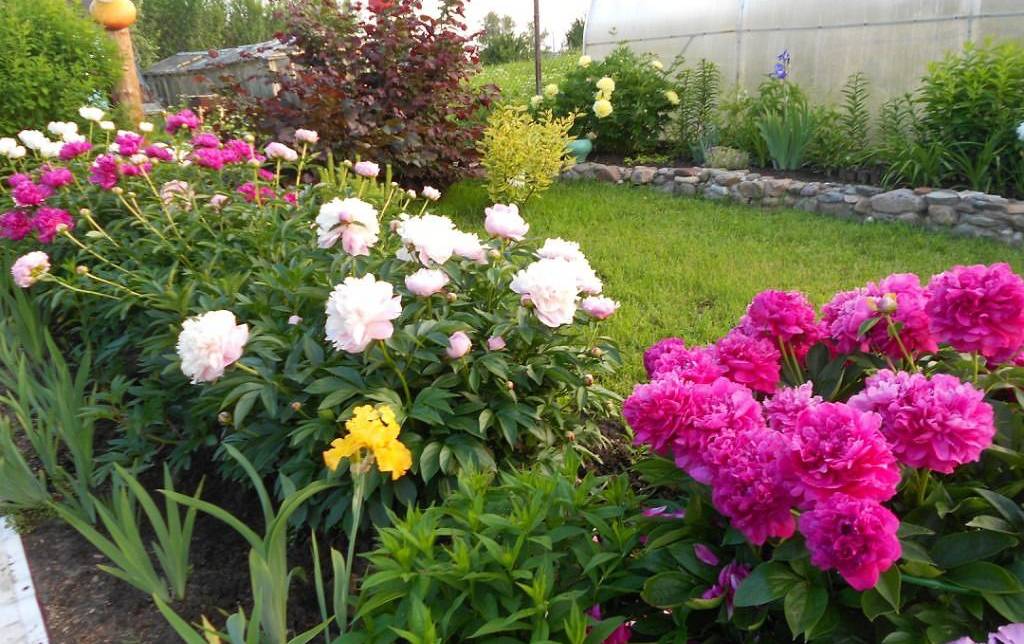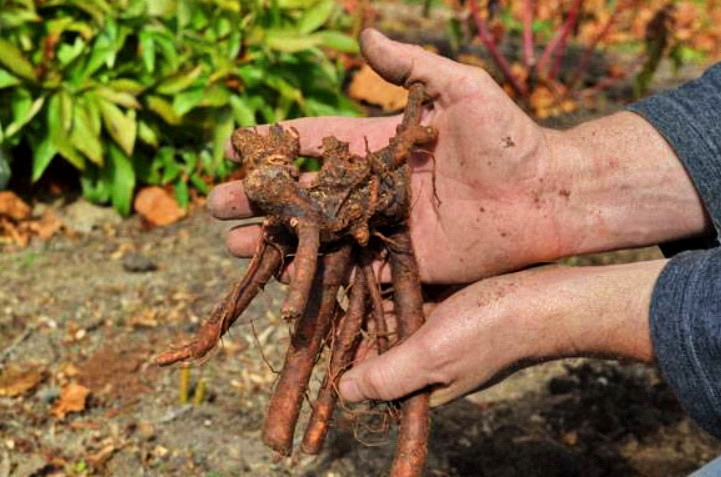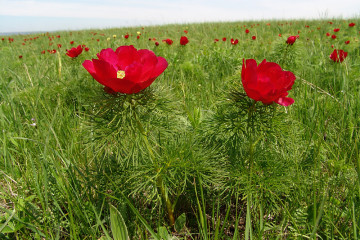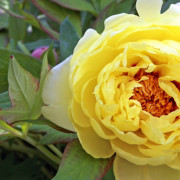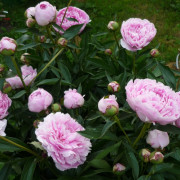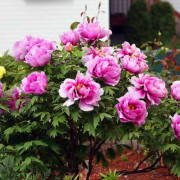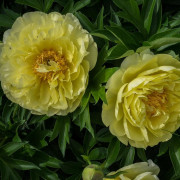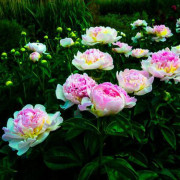Peonies planting and care in the open field in the country
Content:
If peonies are grown, planting and caring for them in the open field has certain characteristics. To achieve a beautiful, abundant flowering, you must follow a number of recommendations. Experienced gardeners advise you to choose a good place, the right planting dates and other important conditions.
What time is better to plant peonies
If peonies are planted in the garden, care and cultivation is carried out in accordance with a number of recommendations. At the same time, it is important to choose the right time for planting. Depending on this, the bush will grow at one rate or another.

For the lush flowering of peonies, it is necessary to carry out the correct planting and provide thorough care.
When to plant peonies? The exact time frame depends on the region. The landing period in Siberia and southern Russia is significantly different:
- In Siberia, it is permissible to plant flowers in August, September.
- In the Urals, the weather is changeable. Peonies should be planted in this region from late August to mid-September.
- In the northwest of Russia, it is permissible to plant perennials a week later than in the Urals.
- In the southern regions, planting work is allowed to be carried out from September to October.
How to plant peonies in spring
It is not recommended to plant peonies in the spring. However, sometimes such a need still arises. In this case, experts advise beginners to use a 2-3 liter pot or box. A tuber should be placed in a container and the container should be placed in a cool and dark place. At home, peonies are often stored in a basement or cellar.
At the end of April or May, the plant can be taken out into the garden and bury right with the pot in the summer cottage. It will be there until the autumn transplant, which is carried out by transshipment with a lump of earth.
Features of planting in the fall
Planting and replanting peonies is recommended in late summer or early autumn. A week before planting, holes should be dug 60 cm deep, observing an interval of 1-1.5 m.
A drainage layer of 20-25 cm should be placed at the bottom of the recess. It should include coarse sand, crushed brick or crushed stone. After that, it is necessary to fertilize with compost and lime. You can also add superphosphate, potassium sulfate, ash to the mixture. It is also useful to use humus. Then, to the top, you need to fill the depression with earth, mixing it with compost.
In a week, by the time the peonies are planted, the soil will sag. At this time, you can place the rhizome of the plant in the hole, sprinkle it with soil and tamp it a little. It is important to consider that peonies do not tolerate deep planting well. Such plants will not be able to bloom.
To wait for a lush flowering, it is necessary to deepen the rhizome so that the upper bud is located under the ground by a maximum of 3-4 cm. Moreover, in the first year, peonies usually do not bloom and seem weak.
Features of planting a tree peony
How to plant tree peonies? This variety of flowers has rather thin roots. Moreover, the points of their growth are in the region of the basal neck. When planting, it is prohibited to deepen it.It is important to leave the neck flush with the ground. When grafting a tree peony to the rhizome, the herbaceous scion should be deepened by 10 cm.
Planting perennial herbaceous peonies
The buds of herbaceous species are located exclusively on the roots. When planting such peonies, the buds should not be deepened more than 3-4 cm from the surface of the earth. At a deeper location, there is a risk of delayed flowering. With high humidity, the kidneys at a depth begin to rot quickly.
Instructions for planting seedlings in open ground
How to plant peonies? To do this, you need to read the step-by-step instructions that will help you achieve excellent results.
How to choose a place for planting peonies
Peonies require a sufficient amount of heat and light. Therefore, they should be planted in that part of the cottage where the sun's rays are constantly present. At the same time, it is not recommended to plant peonies from the windy side or in a shady place. In such conditions, the bushes will grow, but they will not be able to fully bloom.
When choosing a site for peonies in the garden, you should give preference to an area with full air circulation. The landing site should be located away from home. At the same time, it is not recommended to place peonies near trees, as they will experience a lack of moisture and nutrition.
Preparation of seedlings
Answering the question of how to grow peonies, it is worthwhile to separately dwell on the choice of seedlings. When purchasing plant shoots, it is worth clarifying the parameters of their resistance to frost, the height of the bushes, the size and color of the buds. In this case, it is imperative to study the state of the root system and choose the strongest specimens. It is best to buy seedlings 20-25 cm in size.
If there are damaged areas on the roots, they must be cut off. Then sprinkle these areas with charcoal. Old places of cuts should be treated with brilliant green.
To achieve better rooting, it is recommended to soak the seedling in a solution of "Kornevin" or another similar preparation for several hours. After which the delenka should dry out.
When using a delenka from a summer cottage, longer preparation will be required. First, the root of the culture must be washed and dried. Then leave it overnight. This will make the rhizome more elastic. Then it should be divided into several fragments with a sharp knife. Each section should have a length of 10 cm, 3-4 healthy buds and adventitious roots.
Required tools
Before you start planting peonies, you need to prepare everything you need. In general, no specific tools and equipment are required - one shovel is enough. To determine the depth of placement of the kidneys, it is worth installing a stick or rod across the hole.
If it is necessary to separate the delenka from the home bush, a pitchfork will be required. They will make it easier to get out the fragile roots, which are deepened by 1 m. The hole must be dug around the perimeter, after which the roots must be pulled out with a bayonet shovel.
Preparing a pit for planting peonies
The size of the recess should be at least 60 cm. Thanks to this, the bushes will have a full-fledged root system. If the hole is too small, there is a risk of problems with the growth of roots and the normal development of the bushes.
After digging, the hole should be allowed to rest. Due to this, the soil will settle slightly. Then add a mixture of fertilizers to the bottom, a layer of top soil and mix well. This will provide the culture with a sufficient amount of minerals that are required for normal growth.
Features of planting seeds for seedlings and in open ground
To propagate a plant, you need to collect planting material from mid-August to mid-September. At this time, the ripening of peony seeds is observed. From the boxes, you need to choose large brown seeds that have no visible damage.
For reproduction of peonies, the collected seeds must be sown immediately into the ground. The stratification of the planting material is carried out in 2 stages - under the influence of heat and cold. Thanks to this, the seedlings of peonies will begin to develop in early spring. Otherwise, it will be possible to germinate the culture only after a year.
Detailed instructions for breeding peonies by seed method looks like this:
- Before planting, the seeds must be soaked in a solution of potassium permanganate.
- Place in wet sand and place in a warm place for germination. It is important to ensure that the temperature is at least +28 degrees.
- When roots appear, they should be pinched and planted in peat.
- At a temperature of no more than +10 degrees, a growth bud appears in the seed. An escape begins to grow from it.
- Shoots should be planted in separate containers and carefully cared for.
- In the fall, the seedlings can be moved to the beds.
When buying planting material, you should evaluate its appearance. Old seeds have a dry and wrinkled surface.
It should be borne in mind that the cultivation of peonies by the seed method is considered a rather laborious process, which is hardly suitable for novice growers. In addition, this method does not allow plants to preserve varietal characteristics.
Care of young peonies after planting
Throughout the season, the plant experiences planting stress. Therefore, you need to know how to care for peonies. They should definitely be watered, fed, pruned.
Watering
After the autumn planting, it is necessary to water the bushes 2-3 times in the next month - before the frost begins. In the spring, peonies need frequent watering. It can even be daily. Then the amount of soil moisture depends on the weather. It is better to water the flowers in the morning or evening.
Fertilizer
For 2 years, the young peony will have enough fertilizers that were introduced into the recess during planting. After the end of this time, feeding is carried out with the arrival of spring - immediately after awakening. In summer, the bush should be fertilized with mineral fertilizers and organic matter.
Mulching
After planting, the bush must be covered with a mulch layer. It can include some kind of organic matter in the form of peat, sand or compost. With the help of these funds, it will be possible to retain moisture and protect the bush from weeds.
First cut
After the first flowering, the bush should be cut off. Thanks to this, he will not waste energy on the formation of seed pods. At the same time, it is not recommended to cut the stems too short - a few leaves should remain below. This will help form replacement buds in late summer.
Preparation for wintering
When foliage and branches turn yellow, watering should be reduced a little. With the onset of frost, the ground part of the bush should be cut off. This must be done almost to the ground level.
Be sure to cover the bed with a mulch layer of peat. It should be 5-7 cm. This will help the plant survive the winter. With the arrival of spring, the beds must be opened immediately.
To achieve lush and abundant flowering, you need to know how to grow peonies. Plants need proper planting and careful care. In this case, the culture must be watered, cut, tied up in a timely manner. For the winter, the bush should be covered with a mulch layer. It can consist of peat or compost. With the arrival of spring, the shelter must be removed immediately.
